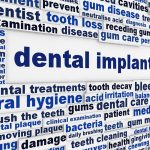
Implant-supported overdentures and implant retained fixed prosthesis are considered to offer advantages over conventional complete dentures for the restoration of edentulous arches. Overdentures have been shown to be more cost-effective than fixed restorations, but fixed appliances allow higher occlusal forces and reduced prosthetic maintenance. However, patients perceptions may not equate with those of clinicians or clinical parameters.
The aim of this review was to compare the patient-reported outcome measures (PROMs) and clinical outcomes associated with implant-supported overdentures and fixed prostheses in edentulous mandibles.
Methods
A review protocol was registered on PROSPERO and searches conducted in the Medline/PubMed, Embase, Scopus, Web of Science, Virtual Health Library, Cochrane Library and OpenGrey databases. Randomised (RCTs) and non-randomised studies (nRCTs) comparing rehabilitation with implant-supported mandibular overdentures and fixed dental prostheses reporting on patient-reported outcome measures (oral health-related quality of life [OHRQoL], and satisfaction) profile and clinical outcomes (survival rate, probing depth, and marginal bone loss) were considered. Two reviewers independently screened and selected studies with methodological bias for RCTs being assessed using the Cochrane risk of bias tool for RCTs (RoB 2). And nRCTS using ROBINS-I tool. OHRQoL and satisfaction analyses were assessed based on the mean difference (MD) between rehabilitations. An intra- participant correlation coefficient of 0.5 was assumed for cross-over studies. Individual analyses were performed for overall satisfaction and comfort, aesthetics, ease of chewing, ease of speaking, ease of cleaning, stability, and retention. Implant survival rate was expressed as risk ratio (RR) and probing depth (PD) and marginal bone loss (MBL) as MD with 95%confidence intervals (CIs). The Grading of Recommendations Assessment, Development, and Evaluation (GRADE) approach was used to assess certainty of the evidence
Results
- 10 studies (5 RCTs,5 nRCTs) involving 288 patients were included
- 4 of the 5 RCTs were considered to be at high risk of bias
- 3 of the 5 nRCTs were considered to be at critical risk of bias and 2 at moderate risk.
- Follow-up periods ranged from 2 months to 10 years.
- OHRQoL was assessed using the Oral Health Impact Profile (OHIP)-14 and OHIP-49 with meta-analyses possible for 6 domains (see table below).
| Domain | No. of studies | SMD (95% CI) |
| Functional limitation | 3 | -0.76 (-1.18 to -0.34) * |
| Physical disability | 3 | -0.70 (-1.12 to -0.28) * |
| Physical pain | 3 | -0.62 (-1.02 to -0.21) * |
| Handicap | 3 | -0.30 (-0.68 to 0.09) |
| Psychological disability | 3 | -0.20 (-0.58 to 0.19) |
| Social disability | 3 | 0.04 (-0.33 to 0.42) |
| Overall | 4 | -0.61 (-1.08 to -0.13) * |
* Lower OHRQoL for overdentures
- Patient satisfaction was measured using visual analogies scales in 4 studies with a number of variables and overall satisfaction meta-analysed (see table below).
| No. of studies | SMD (95% CI) | |
| Comfort | 3 | 0.72 (0.10 to 1.34) * |
| Ease of chewing | 3 | 0.94 (0.41 to 1.47) * |
| Stability | 4 | 0.99 (0.50 to 1.47) * |
| Retention | 3 | 0.93 (0.50 to 1.36) * |
| Ease of cleaning | 4 | -0.91 (-1.29 to -0.52) |
| Ease of speaking | 3 | 0.25 (-0.22 to 0.73) |
| Aesthetics | 3 | 0.21 (-0.26 to 0.68) |
| Overall satisfaction | 2 | 4.84 (1.00 to 8.67) * |
* Favours fixed prosthesis
- The chance of implant survival was similar with overdentures and fixed appliances with 416 of 427 implants placed for overdentures surviving compared with 399 of 402 implants for fixed appliances. RR= 1.00 (95%CI; 0.98 to 1.01).
Conclusions
The authors concluded: –
Fixed rehabilitations for mandibular edentulous patients seem to be a well-accepted treatment from the patients’ oral health perspective. However, mandibular overdentures are no less efficient than fixed prostheses in terms of clinical outcomes.
Comments
The reviewers have searched a wide range of databases only identifying 10 studies meeting the inclusion criteria. Only 5 of the included studies were RCTs and none of the included studies were of low risk of bias. The studies were also small in size with the largest including 48 patients with 3 of the studies having a follow up period ranging from 2 to 4 months. A majority of the studies were conducted in a university or implantology centre settings. While the reviews findings suggest that fixed prosthesis provide greater satisfaction and improvement in OHRQoL over overdentures the findings are based on a small number of studies conducted on a limited number of patients mainly in a university setting so they may not be generalisable. In additional the overall certainty of the evidence is low to very low. Additional high quality well reported studies of appropriate size are required to better assess PROMS for the restoration of the edentulous mandible.
Links
Primary Paper
Borges GA, Barbin T, Dini C, Maia LC, Magno MB, Barão VAR, Mesquita MF. Patient-reported outcome measures and clinical assessment of implant-supported overdentures and fixed prostheses in mandibular edentulous patients: A systematic review and meta-analysis. J Prosthet Dent. 2020 Dec 31:S0022-3913(20)30694-6. doi: 10.1016/j.prosdent.2020.11.005. Epub ahead of print. PMID: 33390270.
Other references
Dental Elf – 13th Jan 2017
Mandibular implant overdentures: Impact on patient based outcomes.
Dental Elf – 22nd Feb 2017
Dental Elf – 7th Apr 2017
